D&D divine domain cosmology for outer plane lore featured art from this article is provided from Eberron: Rising from the Last War by Wizards of the Coast. This article contains affiliate links that add gold to our coffers.
“Many of you wonder, what happens when I die? Today, I am here to tell you that if you’ve lived a holy life, you will be blessed by going to the Upper Planes! On these planes of goodness, you will find paradise. You will find peace from mortal toil! Our gods watch over us from their thrones of power, and they will accept us with open arms, if we follow their tenets and live to our best philosophies! The gods have told us there are many different heavens, and they have shown some of you in this very congregation what awaits in the beyond. So I implore you, from today onwards, make your choices in this life carefully, so that you may find yourself in the embraces of those who guide us from above!”
–Excerpt from a sermon given by Archpriest Krassus in the year 372.
Function, Yes; Form, Not So Much
Breaking with previous editions, 5e chooses to keep the Outer Planes incredibly vague. Whereas previous editions had very strict rules with regard to the layers, their intersections, and how to traverse them, sometimes even creating maps of the layout, 5e went instead with a general nebulous vibe and left it up to DMs to interpret. While this allows a lot of freedom, it also can make it difficult or intimidating to incorporate the Outer Planes. The Dungeon Master’s Guide explicitly instructs DMs to keep descriptive language vague and metaphorical when dealing with the Outer Planes.
The Outer Planes are realms of thought and spirit, and the parts that can be experienced with the senses can be thought of as a border plane. Much more of the plane exists beyond the senses as a realm of the spiritual and likely can only be experienced by souls divorced from their physical bodies.
The shape and experience of each Outer Plane is highly dependent on the deities or powers that control them. Powerful beings can block travel, harrow travelers, and even control distances. However, it is possible to make one’s way through the planes, either by avoiding the notice of the Powers or by pushing through the barriers. Though Asmodeus could make a journey through the Nine Hells arduous, painful, and very very long, adventurers can still make a journey through it.
The Outer Planes mainly function in a mechanical sense to give location to deities, celestials, and fiends and to function as the afterlife for mortal souls. The DM’s Guide gives some cool optional rules for effects for each Outer Plane.
Magic Schools in the Outer Planes
Since the Outer Planes are realms seeped in the magic and powers of gods, AD&D created rules that changed the way players’ spells functioned on the Outer Planes. These could be interesting rules to implement in your game to add an extra element of the players being out of their element when visiting the Outer Planes, but they are by no means a necessary rule.
For a possible hard mode for your players, you can make it so cantrips simply do not function on the Outer Planes. This could be flavored as the background magics overpowering the simplistic magic of cantrips.
Adjuration
In general, repulsing effects, like that from Protection from Good and Evil, have no effect on the native inhabitants of the plane. However, things like Dispel Magic will still work on magical effects produced by inhabitants of the plane.
Conjuration
Non-native creatures to a plane cannot be summoned, and creatures native to the plane can be called upon but not controlled or compelled. Teleportation spells that require the Ethereal Plane do not work, as there is no Ethereal Plane in the Outer Planes (only the Astral Plane). Some forms of teleportation can also be limited by the Power that controls the area. Also, Wish can be denied if the Power of the area decides so.
Divination
Divination is severely limited while in the Outer Planes. Powers can only be contacted if they are in the same plane or adjacent, whatever that means by your cosmological model. Any attempt to detect alignment or magic are overwhelmed by the nature of the plane, and nothing on the plane could be considered truly “natural” or as “nature”.
Enchantment
Confusion effects are affected by the Law-Chaos alignment of the plane, becoming useless on Mechanus and doubly effective on Limbo. Powers with sufficiently high enough Wisdom can suppress Enchantment spells entirely.
Evocation
The local condition of the plane severely affects the behavior of physical manifestation Evocation spells, such as Darkness or the Wall spells.
Illusion
Great enough Powers can ignore Illusion effects. The prolificness of truesight can limit the effectiveness of invisibility. Additionally, on Mechnus, Primus has dictated that Illusion magic does not function.
Necromancy
Spells that raise the dead may fail or be reduced in effectiveness on Planes of good. Additionally, spells that involve a body uninhabited by a spirit may give a small opportunity for a spirit native to the current plane to take control.
Transmutation
Usually, weather is controlled by the Powers and cannot be affected by spells. On realms close to or of chaos, there’s a small chance that spells that create matter or change matter into other shapes have a random effect. This random effect remains within the limits of the spell, just not what one would expect to happen, which can sometimes make the spell useless. This chance increases the closer to chaos one is. Summoning matter remains unaffected.
Mechanus and the Upper Planes
While this article is focused on 5e lore, it will include homebrew ideas and stuff from previous editions. Ideas that are not canon to 5e will be marked as such (NC specifically in the tables). Consider these ideas as helping to build on and expand the existing lore, as 5e gives DMs very little to work with.
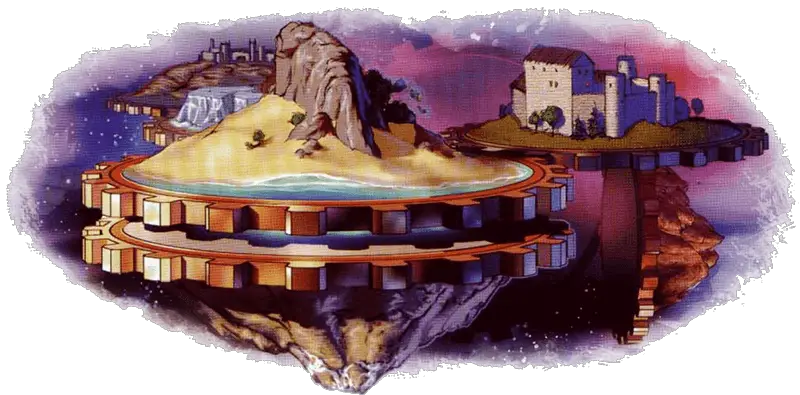
Mechanus, LN
Mechanus is the clockwork plane of pure law. Primus is the head god of the realm, and his mechanical constructions, modrons and other machines, are the main inhabitants. Other gods of law can have their own realm here, but it is rare. The gears that interlock across this plane are engaged in some sort of calculation beyond the scope of any mortal. However, every seventeen completions, the Modrons are sent on a march across the Outer Planes.
Also of note on Mechanus is the Great Modron Cathedral, where a steady flow of newly-created Monodrones (the lowest form of Modron) pour from the doors.
Reasons to visit Mechanus:
- Bounty hunting rogue modrons
- Seeking the help of Primus as a moderator in forging a interplanal contract
- Attempting a heist on a powerful artifact of law
| Deities | Creatures |
|---|---|
| Primus | Modrons |
Arcadia, LN/LG
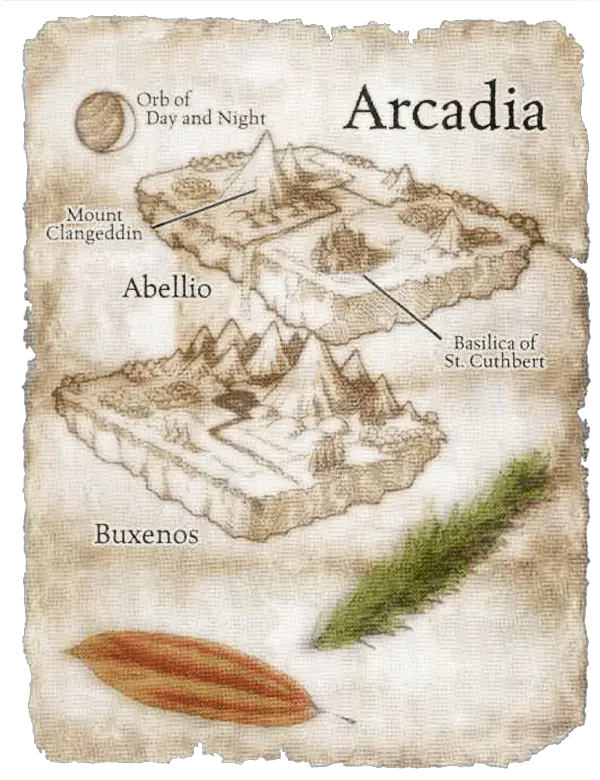
Flawless and eternal, Arcadia is a plane of perfection. The geographical features (streams, mountains, orchards, roads) are ordered and unblemished. Nothing intrudes on harmony.
Pulling from previous edition lore, celestial animals and organized insects could be found on this plane, such as golden foxes, silver sheep, copper hares, bees, and ants. These creatures are good-aligned and not hostile. They do not speak but have pupiless white eyes that pierce any illusion. Militias of spirit-folk can roam the countryside to ensure peace and order are maintained. They may ask good-aligned creatures to patrol alongside them, they often ask neutral-aligned creatures for their business and request they move along, and they will escort evil-aligned creatures or even chaotic-aligned creatures to the nearest portal leaving the plane.
Since there are kingdoms of celestial dwarfs beneath the mountains of Arcadia, if you wish to break from 5e canon, this could be a good location for the Dwarven pantheon to rule from. Since Moradin and the Dwarvish religion is focused on perfection, it may make more sense for the pantheon to be in the plane of perfection over Mount Celestia.
Reasons to visit Arcadia:
- Seeking the help of celestial dwarfs in an interplanar war
- Resolving a dispute where the Storm Kings have begun affecting other planes
| Deities | Creatures |
|---|---|
| The Storm Kings | Celestial animals and organized insectsNC |
| Dwarven PantheonNC | Spirit-folkNC |
| Good-aligned Gods of War | Angels |
| Celestial dwarfs |
Mount Celestia, LG
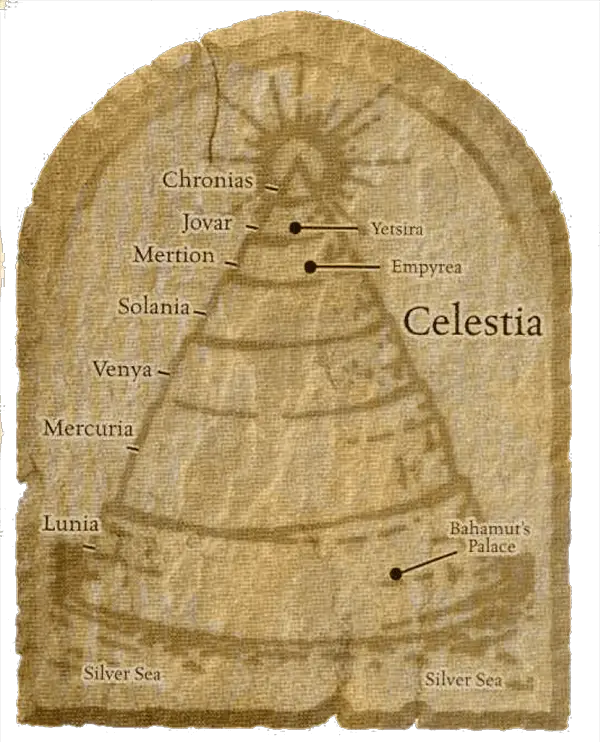
The slopes of Mount Celestia are broken into seven distinct layers, which form the different heavens of this plane. The mountain rises from a silver sea to impossibly high heights surrounded in winds and clouds.
- Lunia: the Silver Heaven
- Mercuria: The Golden Heaven, home of Bahamut
- Venya: Heaven of Pearls, location of the Green Fields, the afterlife for Halflings
- Solania: the Electrum Heaven, location of Moradin and the dwarf pantheon
- Mertion: the Platinum Heaven
- Jovar: the Glittering Heaven
- Chronias: the Illuminated Heaven, but little is known of the highest layer
Reasons to visit Mount Celestia:
- Entreating Bahamut for aid against Tiamat
- Seeking out planar allies in the form of angels
- Attempting to reach the highest level of heaven without being smitten
| Deities | Creatures |
|---|---|
| Bahamut | Angels |
| Moradin and the Dwarf Pantheon | Good-aligned dragons |
| Yondalla and the Halfling Pantheon |
Bytopia, LG/NG
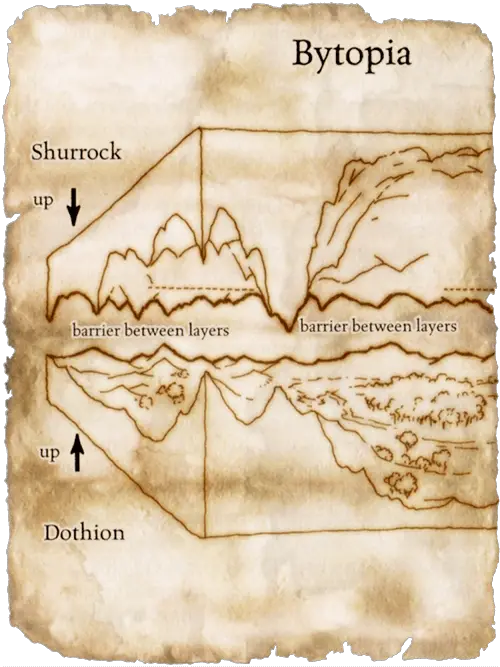
A realm split in half, Bytopia consists of two layers, historically called Dothion and Shurrock. Dothion is a pastoral landscape full of forests of great oaks, meadows of flowers, and dreamy grasslands. Shurrock is an idyllic but untamed wilderness, showcasing the beauty of unbroken nature. On this plane, you can find the Seven Golden Hills of the Gnome pantheon.
In AD&D, the planes were presented like a book without a spine, so that a visitor on one half could look into the sky and see the other half overhead and upside down. Halfway between them, gravity switches direction, so a traveler can change sides just by climbing a mountain sufficiently tall enough.
Reasons to visit Bytopia:
- Attempting to reach the inner sanctum of the Hidden Knoll to find a rare artifact
- Tracking down a rare plant for a magic item recipe
| Deities | Creatures |
|---|---|
| Garl Glittergold and the Gnome Pantheon | Semi-intelligent (but speechless) animalsNC |
Elysium, NG
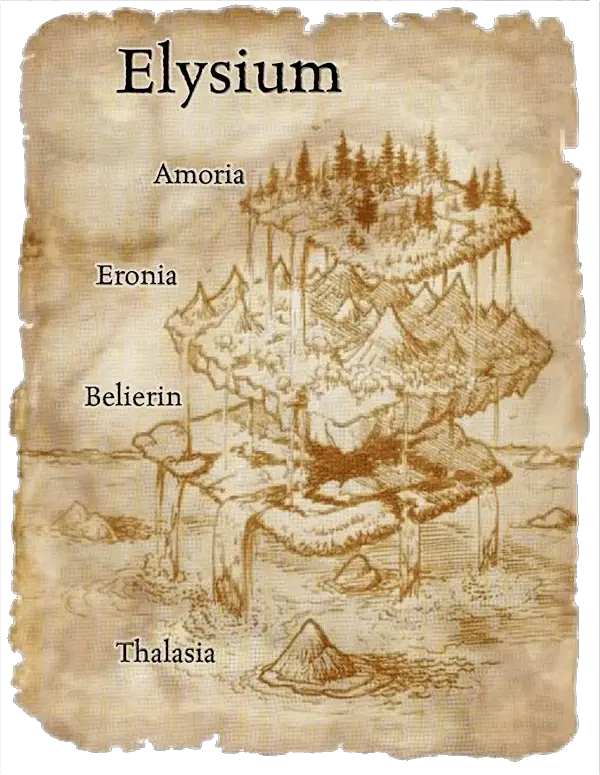
Based on the Elysium Fields of Greek myth, this plane is paradise for all souls who end up here. A river runs through all the different layers of Elysium, which vary from marshes to fertile grasslands to pine forests to even a sea. In previous editions, this river also runs through The Beastlands and Arboria, acting similar to the River Styx of the Lower Planes.
An interesting effect you could inherit from previous editions is that spirits and souls from this realm cannot be summoned or controlled, as they are truly at rest.
Reasons to visit Elysium:
- Using the River Oceanus to travel to a different plane
- Seeking out a Phoenix for a material component for a spell, potion, or magic item
- Petitioning a Moon Dog to go on a demon hunt with you
- Seeking safe haven from planar troubles
| Deities | Creatures |
|---|---|
| PhoenixesNC | |
| Moon DogsNC |
The Beastlands, NG/CG
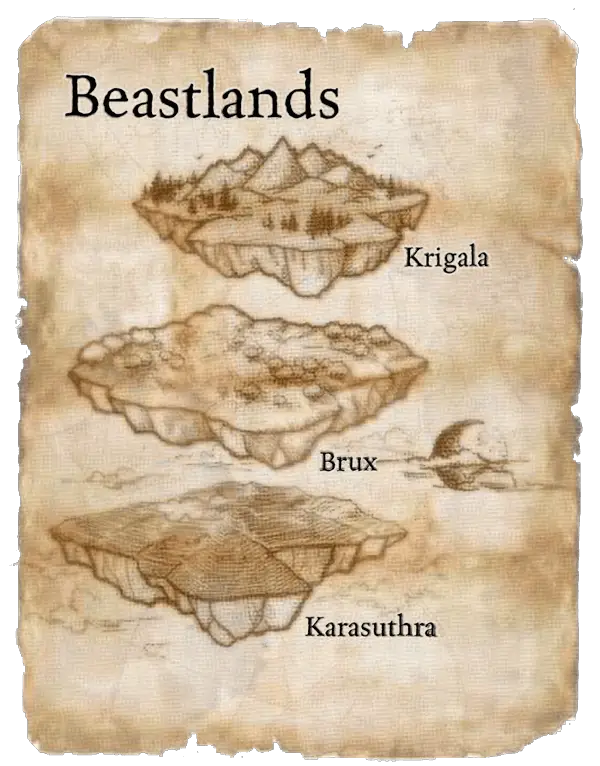
The Beastlands is a densely forested plane that embodies untamed nature’s beauty. Every type of forest on the Material Plane can be found here, and all of it is teeming with life. A unique trait of the Beastlands from previous editions was that every animal is a celestial spirit capable of speech, and some even capable of spellcasting. Humanoids are seen as temporary visitors on this plane, and gods are incredibly rare. The main powers of this plane are the Beast Lords.
Another fun little detail you could include are the Faces in the Clouds, spirits that take the form of clouds that also control the weather of the Beastlands.
Reasons to visit the Beastlands:
- Seeking mercy from one of the Beast Lords to remove a curse given for disrespecting beastkind
- Joining a Beast Lord on a planar hunt
| Deities | Creatures |
|---|---|
| Beast LordsNC | Celestial animalsNC |
| Centaur PantheonNC | Intelligent cloudsNC |
Arborea, CG
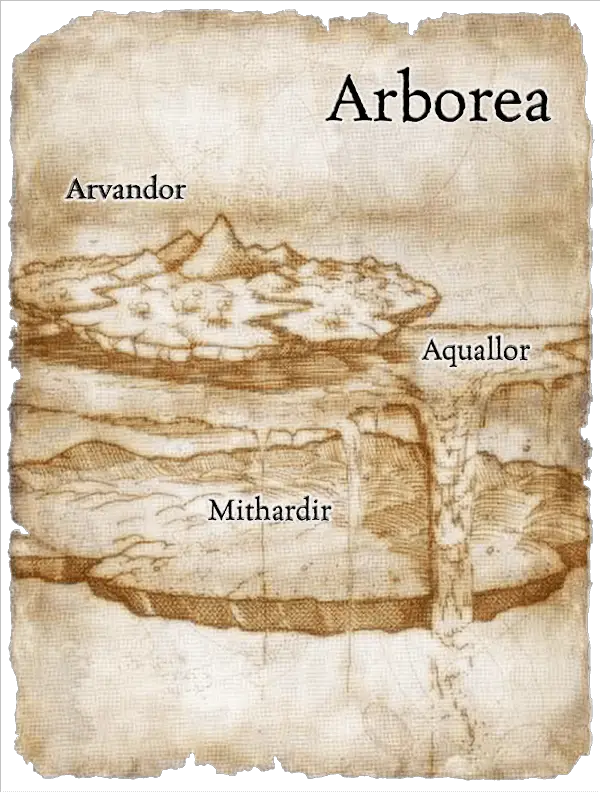
Named Olympus in previous editions, Arborea is colossal, epic, titanic. Emotions, locations, creatures, everything on this plane is larger than life. Some of the layers reflect Greek myth and topography, while others, like the one the Elvish Pantheon is on, are more similar to the Feywild. Previous editions had a layer that reflected the Greek god Poseidon and the Sea Elf pantheon.
Reasons to visit Arborea:
- Seeking to accomplish a great feat to prove your worth
- Hunting for treasure buried in the white sands of a dead layer where the deities that once ruled are long gone
- Hunting mythic beasts for rare components for spells, potions, or magic items
| Deities | Creatures |
|---|---|
| Corellon Larethian and the Elf Pantheon | Giant animalsNC |
| Mythic beasts of Greek legendNC | |
| Celestial elves |
Ysgard, CG/CN
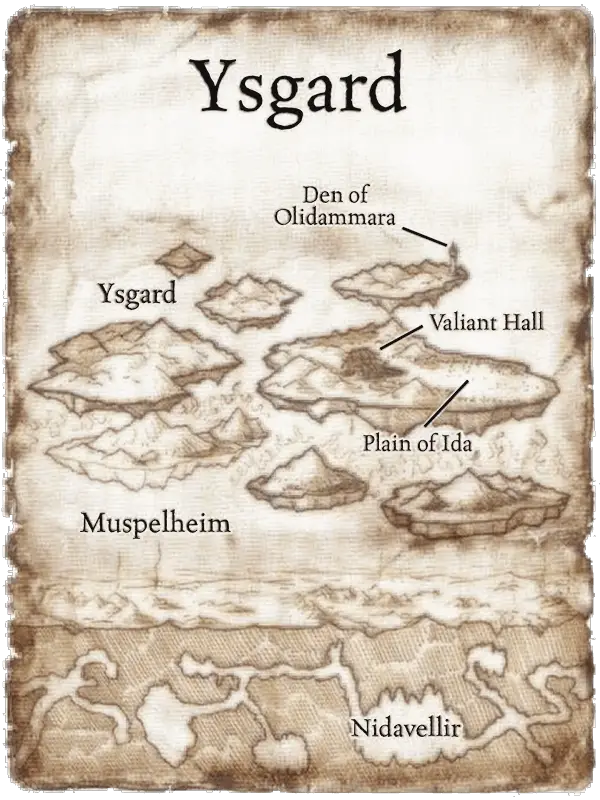
Somewhat inspired by Norse mythology, Ysgard is a chaotic realm with geological features similar to Scandinavia or Germany. Ysgard is composed of giant continents floating on a sea of magma. Since the plane is close to the ideological idea of chaos, the landscape could be constantly changing as the continents move, crash together, and break apart.
Reasons to visit Ysgard:
- Proving your mettle against the harshness of the plane
- Hunting legendary giants or dragons as a trial to gain the support of a deity
| Deities | Creatures |
|---|---|
| Grolantor, giant godNC | Massive beastsNC |
| Giants | |
| Dragons |
Conclusion
The Upper Planes often don’t see a lot of love when it comes to D&D games, and when they do, it’s mostly for high level games. However, they can be useful in all sorts of scenarios. High level players can hunt across the sometimes dangerous Upper Planes for extraplanar allies and support. Mid level players can find themselves teleported to Arboria or Ysgard to complete tasks or trials to earn the favor of a god. Lower level players could start having visions or dreams of some of the more peaceful planes like Elysium to foreshadow events or set the mood or theme of the campaign; paladins and clerics especially can benefit from more connection to their religion’s patron and afterlife. The Outer Planes in general can serve as a way to introduce the players to forces beyond the Material Plane, to powers far greater than any mortals, to gods and angels, and possibly even divine ascension. Whether it’s just one plane in specific or the whole lot, the Upper Planes can add a lot to your campaign’s lore.
You can find more D&D planar summaries by author Light here.





Great article!